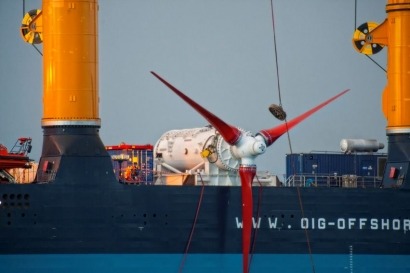
The 1-MW power generator was installed last December, in some of the worst weather conditions Scotland has experienced in more than a decade, and has since been undergoing a range of tests in the fast flowing tidal waters around Orkney. The initial testing period has been very positive with the device achieving full export power.
The test device in Orkney aims to fully prove that the technology can operate efficiently in Scotland’s fast flowing tides, that monitoring and maintenance operations can be honed and to help drive down costs in operations and installation. ScottishPower Renewables (SPR) plan to use this technology as part of the world’s first tidal turbine array in the Sound of Islay. The company’s plans to develop a 10MW tidal array in Islay received planning consent from the Scottish Government in March 2011.
“The concept of generating electricity from the natural movement of the tide is still relatively new – and test projects like this are vital to help us understand how we can fully realise the potential of this substantial energy source,” explains Keith Anderson, CEO of ScottishPower Renewables. “The performance of the first HS1000 device has given us great confidence so far. Engineers were able install the device during atrocious weather conditions, and it has been operating to a very high standard ever since. We have already greatly developed our understanding of tidal power generation, and this gives us confidence ahead of implementing larger scale projects in Islay and the Pentland Firth.”
The HS1000 tidal turbine has been developed by ANDRITZ HYDRO Hammerfest, whose majority shareholder is Andritz Hydro, and also includes partners Iberdrola and Hammerfest Energi. The 1-MW machine can power the annual electricity needs of 500 homes.
Seen as one of the world’s most advanced tidal turbine designs, a prototype device has been generating electricity in Norway for over 6 years. The design is based on a mixture of technology used in traditional onshore wind turbines, subsea oil & gas production and in hydro-power plants.
The turbine can be monitored from the European Marine Energy Centre (EMEC) base in Eday, but engineers can also operate and inspect the device from Glasgow using mobile connections and an on-board camera.
“The 1-MW pre-commercial device is an important step in our staged strategy for developing reliable and cost efficient tidal energy converting devices and power plants. The tests being carried out so far have confirmed the design basis for the technology and given comfort concerning the device’s capacity,” commented Stein Atle Andersen, Managing Director of ANDRITZ HYDRO Hammerfest. “We are still early in the testing programme with endurance, availability and reliability being the most imminent factors for asserting a proper basis for developing commercial tidal energy power plants. However, we are already well into design engineering for the first power plant.”
Commenting on yesterday’s news, WWF Scotland Director, Richard Dixon, said: "It’s great news that this underwater turbine has not only successfully completed its initial testing phase but also been able to provide electricity for homes and businesses on the island. This news represents another step forward for the marine renewable industry in Scotland. There is a massive amount of power in our seas and Scotland is well placed to lead in developing the technologies to turn this potential into clean, green electricity.
Dixon highlighted that alongside energy-saving measures, wave and tidal energy have a critical role to play in meeting the Government’s commitment to decarbonise the power supply by 2030.
For additional information:

